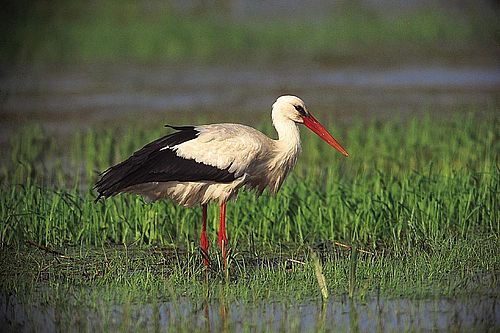More room for our storks
From 29 June to 3 July 2016, all life revolved around the white stork in the Hungarian village of Nagybajom. More than 60 representatives of "European Stork Villages" from 13 different European countries converged on this little town of just three and a half thousand inhabitants in southwest Hungary. +++ “European Stork Villages” are creating new habitats for the white stork

Radolfzell. From 29 June to 3 July 2016, all life revolved around the white stork in the Hungarian village of Nagybajom. More than 60 representatives of "European Stork Villages" from13 different European countries converged on this little town of just three and a half thousand inhabitants in southwest Hungary. “Despite the positive developments in some regions, the white stork is still threatened by the incredibly rapid change in agricultural use in Europe. Every day, several hundred more hectares of species-rich meadows and pasture disappear in Europe,” warned Gabriel Schwaderer, head of the EuroNatur foundation, in Nagybajom.
The goal of the network’s 13th conference was to learn from the practical experience of other stork villages and work together to drive forward the protection of storks and their habitats. As well as the mayors and representatives of the stork villages, a number of international experts in nature conservation took part in the conference. In their lectures, they used examples to show how wet meadows and pasture, which are some of the most important feeding grounds for the white stork, can be successfully rewilded and preserved.
Back in early 2014, using funding from the Pancivis foundation and the Aage V. Jensen foundation, EuroNatur set up a project together with the Swiss foundation Ciconia to support European stork villages in particular in effectively conserving and extending the wet meadows and pasture in their countries. To create optimum conditions for the stork and its breeding, action such as rewilding and the extensive grazing of wet meadows was promoted.
In some stork villages, these measures have already been taken and met with success. Now the partners in our network can benefit from their experience, as they are also planning to implement projects to protect stork habitat over the next two years. Discussions included the host of this year’s conference, Nagybajom. On an excursion to the project area, representatives of the Hungarian stork village had a chance to talk to other conference delegates about how the action they are planning can be successfully implemented, illustrating it with the real-life examples before them.
Background information:
European Stork Villages: Since 1994, EuroNatur has awarded the title of “European Stork Village” to districts with many storks and a marked commitment to stork conservation. Nagybajom has held the title since 1996, being the second of the now 15 European Stork Villages to be honoured in this way. The latest addition to the network is the Greek village of Poros, which received its title on 11 June 2016. In Germany, the village of Rühstädt, located in the Elbe Brandenburg River Landscape biosphere reserve, has been part of the network since1996.
Queries: EuroNatur, Westendstr. 3, 78315 Radolfzell, Germany Tel.: +49 (0)7732 - 92 72 24, Fax: +49 (0)7732 - 92 72 22, email: info(at)euronatur.org, contact: Gabriel Schwaderer, press contact: Christian Stielow
 Report sighting
Report sighting
Have you seen a white stork or another interesting species of animal, plant or fungus? Make your observation count for nature conservation and share it with other nature lovers! It’s free and it’s fun!





